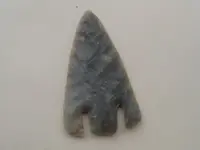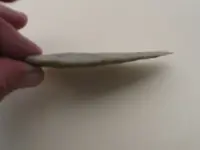RGINN said:
Cool find. Neanderthal, what was the purpose of the deep notching on the Calf Creek points and how were they mounted? How were they launched? I've seen that picture of one buried in a bison skull (somebody missed a shot) and it took a lot of force to bury it in there.
I think the deep notching could have served a few purposes. Like I mentioned earlier, punch notching undoubtedly started in the northeast. Through diffusion, that technology was learned and then utilized. the deep notches gave a larger stem area to haft to, and retaining the long barbs gave them more flint to work with. I'm sure there was a measure of pride in it also, showing off their ability to create something so intricate and hard to master.
Kim Holt is the fellow who found the bison skull with a Calf embedded in it in Tulsa County. Unfortunately, Kim passed away last year. He donated the skull to the Sam Noble museum up in OKC. There was even a program on tv (History's Mysteries) with the skull. The skull is problematical, and caused quite a stir. For one thing, your typical Calf Creeks aren't really projectiles. The long barbs would break far too easily, and Calf Creek points always exhibit signs of being used as knives - the beveled resharpening, serrated edges, the top 1/3 being the most heavily resharpened part of the blades, etc. This is why the buffalo skull blew everyone away. If Calf Creeks are knives, how did it become embedded in the skull? It only seems logical that at least that one was used a projectile...or was it? It's my opinion that it's entirely possible that it could have been a defensive measure. First, look at how deep that is embedded in the skull. That would take an INCREDIBLE amount of force to impel that in there with a throw or even a thrust. It's lodged in one of the thicker parts of the skull, near the horn core. The full blade length is embedded, up to the notches! It has been opined that perhaps it was an atlatl shot, but I find that absurd. Firstly, the blade is far too large to have tipped an atlatl dart, and I can't foresee an abo tipping an atlatl with a point that is so fragile, the ears would have broken off with any throw.
I used to do alot of experimental archaeology years ago, and still do it to some degree to this day. I have shot more flint tipped arrows and utilized more flint tools than I'd care to remember. I am planning on trying to recreate possible ways in which the Calf Creek could have become lodged in the skull. By using fresh bison skulls and modern knapped Calf Creek points, we will try to determine possible scenarios. It's already in the works. The whole process will be photo documented for all to see.



 Too funny. NG, listen to Matt he knows what he is talking about. I was very fortunate to have Matt teach me lots of topics concerning artifacts/IDing, when I first started out.( I still pick Matts brain) I am so greatful for that, otherwise I would have been none the wiser with everyones different views
Too funny. NG, listen to Matt he knows what he is talking about. I was very fortunate to have Matt teach me lots of topics concerning artifacts/IDing, when I first started out.( I still pick Matts brain) I am so greatful for that, otherwise I would have been none the wiser with everyones different views 

 ( No Offence ppl, just gets confusing as a newbie, in 12 month NG will have her own thoughts on the matter)
( No Offence ppl, just gets confusing as a newbie, in 12 month NG will have her own thoughts on the matter) 